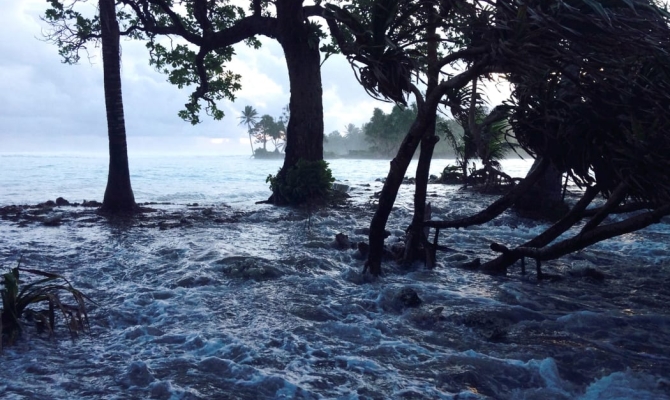At its highest point, the Republic of the Marshall Islands (RMI) stands at two metres above sea level.
As people of a low-lying atoll nation, the Marshallese face an existential threat from climate change impacts, specifically sea level rise.
According to the IPCC Special Report on Oceans and Cryosphere in a Changing Climate (SROCC), sea level rise will continue beyond 2100, in a low emissions scenario this can mean a 1-metre rise by 2300, and a 5.4-metre rise in a high emissions scenario.
For a country like Marshall Islands, a 1-metre sea level rise will mean 40 percent of the buildings in its capital city, Majuro would be permanently inundated and flooded, and entire islands will disappear, according to a study conducted by the Marshall Islands government and the World Bank in 2021.
“The current climate projections have dire consequences for our people, it means coastal erosion, significant loss of land and homes, increased salinisation in water sources and loss of livelihoods for our people”, Warwick Harris, Deputy Director of the RMI Climate Change Directorate reflects on recent occurrences. “Every little increase in sea levels is a matter of life quality for the Marshall Islands”, he says.
The sentiment was echoed by University of the South Pacific Director of the Pacific Centre for Environment and Sustainable Development and IPCC Report author, Professor Elisabeth Holland, when she spoke at length about the impacts of sea level rise on the Pacific at the Sea’ties workshop on ‘Adapting Coastal Cities and Territories to Sea Level Risk in the Pacific’, jointly coordinated by the Secretariat of the Pacific Regional Environment Programme(SPREP), Pacific Climate Change Centre and Ocean & Climate Platform.
Professor Holland says, “every centimetre of sea level rise matters. When we begin to lose every centimetre of our islands and culture, as result of climate change impact, we need to become stronger as a collective to address these issues. Slowing down sea level rise is essential for adaptation in coastal communities to be successful.”
Also presenting at the workshop, Professor Jon Barnett of the University of Melbourne shared on impacts and responses to sea-level rise on the frontlines in the Marshall Islands. In a partnership between the University and the International Organisation for Migration in Majuro with local partners, a study was conducted across 15 atolls in RMI, on the human impacts of climate change. Data was collected through community consultations as part of two projects, the development of the RMI National Adaptation Plan (NAP) and the Climate Security in the Pacific Project.
Professor Barnett highlights the outcomes of the study, “the most common observation of climate change impact was sea level rise, followed by temperature rise, drought and erratic rainfall.” During a site visit to Wotho, other impacts observed on the island atoll was inundation of the airport runway, coastal erosion, coral bleaching and rising salinity and contamination of wells.
He further shares, “increasing salinisation in soils and groundwater as a result of sea level rise has led to damage of crops and food insecurity, which majority of respondents identified as the most common social impact. Fish was reported as harder to catch, fish had moved further from traditional fishing grounds, so fishermen now had to travel further to catch fish and spend more money on fuel, thus also contributing to a decrease in food security”.
In response to the mounting impacts of climate change and sea level rise, the Marshallese are using their collective action and traditional knowledge to adapt to the changes. An example is the use of pandanus, grown on shorelines to dissipate wind and wave energy during storms and wave surges, with the added benefit of using the materials for handicrafts. Evidence of coral farming and community driven seawalls were observed as measures in response to the rising sea levels.
Despite the observed impacts of sea level rise, the Marshallese people have shown strong intent to remain in their lands. Long term adaptation pathways are critical in ensuring this, and can range from investment in Early Warning Systems and Nature-based solutions to infrastructure design. Other pathways are dialogues on land tenure and land reclamation which must be carefully planned and regulated. These pathways are critically important and must be locally driven.
Without climate adaptation measures, RMI will be one of the first countries to face real existential threat due to sea level rise. Therefore, putting in place solid adaptation pathways ensure the Marshallese can remain in their home land even in the face of climate change impact and sea level rise.
The Adapting Coastal Cities and Territories to Sea Level Risk in the Pacific workshop is held from 10 – 12 July 2023 in Nadi Fiji.The workshop is bringing together government representatives, practitioners, collaborating partners, researchers, and NGOs from across the Pacific Islands.
SOURCE: SPREP/PACNEWS














